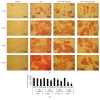A Citrus bergamia Extract Decreases Adipogenesis and Increases Lipolysis by Modulating PPAR Levels in Mesenchymal Stem Cells from Human Adipose Tissue
- PMID: 27403151
- PMCID: PMC4926019
- DOI: 10.1155/2016/4563815
A Citrus bergamia Extract Decreases Adipogenesis and Increases Lipolysis by Modulating PPAR Levels in Mesenchymal Stem Cells from Human Adipose Tissue
Abstract
The aim of this research was to assess the impact of a well-characterized extract from Citrus bergamia juice on adipogenesis and/or lipolysis using mesenchymal stem cells from human adipose tissue as a cell model. To evaluate the effects on adipogenesis, some cell cultures were treated with adipogenic medium plus 10 or 100 μg/mL of extract. To determine the properties on lipolysis, additional mesenchymal stem cells were cultured with adipogenic medium for 14 days and after this time added with Citrus bergamia for further 14 days. To verify adipogenic differentiation, oil red O staining at 7, 14, 21, and 28 days was performed. Moreover, the expression of peroxisome proliferator-activated receptor gamma (PPAR-γ), adipocytes fatty acid-binding protein (A-FABP), adipose triglyceride lipase (ATGL), hormone-sensitive lipase (HSL), monoglyceride lipase (MGL), 5'-adenosine monophosphate-activated protein kinase (AMPK)α1/2, and pAMPKα1/2 was evaluated by Western blot analysis and the release of glycerol by colorimetric assay. Citrus bergamia extract suppressed the accumulation of intracellular lipids in mesenchymal stem cells during adipogenic differentiation and promoted lipolysis by repressing the expression of adipogenic genes and activating lipolytic genes. Citrus bergamia extract could be a useful natural product for improving adipose mobilization in obesity-related disorders.
Figures






Similar articles
-
Combination of Garcinia cambogia Extract and Pear Pomace Extract Additively Suppresses Adipogenesis and Enhances Lipolysis in 3T3-L1 Cells.Pharmacogn Mag. 2018 Apr-Jun;14(54):220-226. doi: 10.4103/pm.pm_388_17. Epub 2018 Apr 10. Pharmacogn Mag. 2018. PMID: 29720835 Free PMC article.
-
Fat-reducing effects of dehydroepiandrosterone involve upregulation of ATGL and HSL expression, and stimulation of lipolysis in adipose tissue.Steroids. 2012 Nov;77(13):1359-65. doi: 10.1016/j.steroids.2012.08.002. Epub 2012 Aug 23. Steroids. 2012. PMID: 22951290
-
Synergistic effects of cAMP-dependent protein kinase A and AMP-activated protein kinase on lipolysis in kinsenoside-treated C3H10T1/2 adipocytes.Phytomedicine. 2019 Mar 1;55:255-263. doi: 10.1016/j.phymed.2018.06.043. Epub 2018 Aug 11. Phytomedicine. 2019. PMID: 30668437
-
Allium hookeri Root Extract Inhibits Adipogenesis by Promoting Lipolysis in High Fat Diet-Induced Obese Mice.Nutrients. 2019 Sep 20;11(10):2262. doi: 10.3390/nu11102262. Nutrients. 2019. PMID: 31547031 Free PMC article.
-
Fat Cell and Fatty Acid Turnover in Obesity.Adv Exp Med Biol. 2017;960:135-160. doi: 10.1007/978-3-319-48382-5_6. Adv Exp Med Biol. 2017. PMID: 28585198 Review.
Cited by
-
Adipose-Derived Mesenchymal Stromal Cells: A Tool for Bone and Cartilage Repair.Biomedicines. 2023 Jun 21;11(7):1781. doi: 10.3390/biomedicines11071781. Biomedicines. 2023. PMID: 37509421 Free PMC article. Review.
-
Biological effects of melatonin on human adipose‑derived mesenchymal stem cells.Int J Mol Med. 2019 Dec;44(6):2234-2244. doi: 10.3892/ijmm.2019.4356. Epub 2019 Sep 27. Int J Mol Med. 2019. PMID: 31573052 Free PMC article.
-
The Rosiglitazone-Like Effects of Vitexilactone, a Constituent from Vitex trifolia L. in 3T3-L1 Preadipocytes.Molecules. 2017 Nov 22;22(11):2030. doi: 10.3390/molecules22112030. Molecules. 2017. PMID: 29165364 Free PMC article.
-
Novel Neohesperidin Dihydrochalcone Analogue Inhibits Adipogenic Differentiation of Human Adipose-Derived Stem Cells through the Nrf2 Pathway.Int J Mol Sci. 2018 Jul 29;19(8):2215. doi: 10.3390/ijms19082215. Int J Mol Sci. 2018. PMID: 30060630 Free PMC article.
-
Molecular Mechanisms and Therapeutic Implications of Human Pericyte-like Adipose-Derived Mesenchymal Stem Cells in an In Vitro Model of Diabetic Retinopathy.Int J Mol Sci. 2024 Feb 1;25(3):1774. doi: 10.3390/ijms25031774. Int J Mol Sci. 2024. PMID: 38339053 Free PMC article.
References
LinkOut - more resources
Full Text Sources
Other Literature Sources
Research Materials

